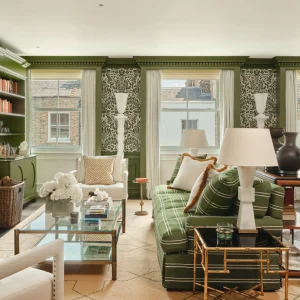
John Madin, Birmingham’s most famous 20th-century architect, would surely have loved Architex. It was a construction set for children, of all ages, made in England in the Sixties. I had one. Yellow plastic I-beams could be clipped together with clear plastic joints to create the frames of sub-Miesian or sub-SOM-style office blocks. With plasticised cardboard floors slotted into place, and cladding with clear plastic windows pressed into frames – hey presto! – you had created yet another scale-model office block that looked much like Madin’s Birmingham Post and Mail newspaper HQ of 1964, since demolished.
Architex seemed more sophisticated, and certainly more modernist, than Bayko, another childhood favourite; a construction set dating from the late Thirties, this allowed you to build a variety of pitched roofed and bay-windowed suburban villas, of the kind that were being rushed up around Birmingham when John Madin was growing up there in a detached Victorian villa in Moseley, birthplace of JRR Tolkien of Lord of the Rings fame, Neville ‘Peace in Our Time’ Chamberlain and Ali Campbell, founder and lead singer of UB40.
I mention these construction sets because while reading about Madin for this article, I came across a delightful and revealing black-and-white documentary made in 1965 when the architect, then 41, was reaching the height of his powers. Directed by John Bird and produced by Philip Donnellan, this was one a series of six films called Six Men, portraying the half-dozen top professionals doing most to push Birmingham into the era of shopping centres, 100mph InterCity electrics, Spaghetti Junction, six-cylinder BMC Pininfarina saloons, jet aircraft, cigarette smoke and comprehensive development.

In Bird’s film, Madin, who died in January this year, is shown as a thrusting, go-ahead, chap living in a modern house of his own design and, when not water skiing on fashionable Midlands reservoirs, racing Scalextric cars at home with his three children, or jetting to London – champagne all the way – in a BEA Trident, is seen dressed in tailored tweeds, sucking at a pipe and running the country’s third largest private practice – John HD Madin and Partners – at the time specialising in producing Architex-like buildings in and around Birmingham.
How quickly this young wartime Royal Engineers officer rose to the top of his professional tree. Just eight years before completing the Post and Mail building, he had been paid £6 10s [£6.50] to design a suburban house extension; fees for the Lever House-style newspaper office were £155,000. Asked by Bird what he wanted to do most, Madin suggested the design of an entire new town, built for a new way of life and designed down to the last new detail. How he loved ‘comprehensive development’, and, a few years later, how fondly he liked to imagine his most famous building – Birmingham Central Library – as the hub, and modern heart, of a completely rebuilt city centre designed in its entirety by… John Madin.
It is touching to watch that episode of Six Men today, when Madin’s library is set to be demolished, though when compared with the new Library of Birmingham nearing completion close by, Madin’s library, opened in January 1974, seems modest. It was to have been clad in Travertine or Portland stone, but ended up – given a shortage of cash – brute-concrete naked. The brooding, fortress-like appearance of the main block – the reference library in the guise of an inverted, eight-storey ziggurat – has probably done the building no favours in the popular imagination, while the atrium and public concourse at the heart of the building is now a part of a shopping complex called Paradise Forum.

Can this really be heaven, I wondered as I scuttled through the world of McDonald’s, City Nails, Spar and JD Wetherspoon? How are these emporia meant to complement the library? Not at all really, and yet it hardly matters now that the building has been condemned, despite lively local and national campaigns – principally by the Twentieth Century Society – to save it.
Without the ‘comprehensive development’ surrounding it, the library has always been an architectural one-off, an anomaly rather than a blueprint for a futuristic city centre that never happened. So, the building – ‘functional, not brutal’, said Madin – seems out of sorts and out of place today, especially as it has been flanked, since the mid-Eighties, by the tacky-looking, steel and glass Copthorne Hotel (Architex would do a better job) – and hemmed in by a swirling carpet of horrid herringbone brick pavement, pricked with ‘heritage’-style signposts and potted plants better suited to a patio in Moseley than a civic square.

Inside, the Madin building proves to be rather fine and with a little imagination, it could yet become a much-admired and popular art gallery as well as a reference library, while it is big enough to house all sorts of spaces and activities for clubs and societies as well as cafes and restaurants, a cinema and, well… pretty much anything anyone except that local councillors and their officers, hell-bent on turning Paradise Forum and the library into lucrative real estate, might come up with. The building could then work again, as it was intended to do, as a civic design of the future.
Whatever one makes of the decision to build a new central library here, it is good to see that at least the site is on Centenary Square in the city centre rather than on its East Side, as was the case some years when Richard Rogers was asked to design an ambitious replacement for Madin’s library. This never happened. It is difficult, though, to judge the giant new, yet incomplete, Library of Birmingham designed by the Dutch firm, Mecanoo, which – founded in 1984 – took its name from Meccano, another model construction set.
Centred around a cavernous internal atrium, the spaces here are even bigger than Madin’s. The most controversial aspect of the building is probably the vast necklace of aluminium circles wrapped around its facades. These can represent whatever takes your fancy – jewellery, wheels, generic patterns found in cultures worldwide – but will certainly mark the building out as being different from its neighbours.

If, in fact, you take a stroll from the almost comically grim New Street station (designed by Kenneth J Davies of British Rail’s London Midland Region, and opened in 1967) up and through Madin’s Central Library and on to Centenary Square, what is most striking is the manner in which these great disconnected chunks of the city appear to be composed of individual – and sometimes highly individualistic – buildings that appear to be talking to themselves; the architecture of central Birmingham seems uninterested in conversation. It needs stitching together comprehensively. John Madin was the last architect to try to do this and his style appears not just to be out of fashion, but to have been condemned out of hand: at least four of his major buildings have been demolished over the past few years. The library is next.
‘You can only do the best you can at the time,’ says Madin in Six Men, doing his best to look philosophical. Clearly his Architex-best was not enough for the brave and shiny new Birmingham of the 21st century.





